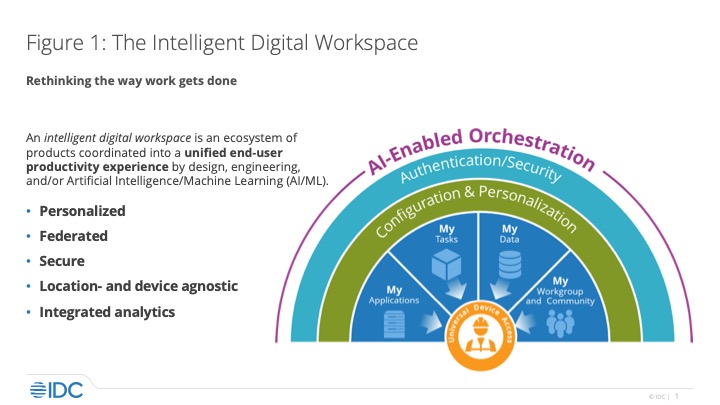Intelligent Digital Workspace — What Is It and Why Do We Need It? |
| By Holly Muscolino |
|
|
|
Imagine that you walk into your corporate office in the morning, turn on your computer, log-in to your workspace, and it greets you and presents your next priority task for the day. Without leaving that environment, the workspace launches the required application and opens widgets with the data and/or content that you need to complete that task. It starts a conversation with your collaborator and mentions to you that a certain other subject matter expert at your company may be a useful resource. You don't complete that task by the end of your workday, but when you start work from your home office the next morning, all resources are still in place, and you pick up right where you left off with the same experience. This may sound a bit futuristic, but this vision is being articulated by a number of technology vendors and service providers as they develop the ecosystem that IDC calls an intelligent digital workspace (IDW). At its essence, the IDW is fundamental change in how we deliver technology resources to a worker, that puts the worker at the center. The IDW ecosystem flips traditional end-user computing on its head, bringing technology, data and collaborators to workers with a federated and customized, or even personalized, approach. The intelligent digital workspace improves worker productivity and experience by reducing context switching and ensuring that all required resources are available anytime and anywhere and on any device — to office workers, knowledge workers and frontline workers. The intelligent digital workspace enables employees to work better together in dynamic and distributed teams and supports the emerging hybrid work model. IDC defines an intelligent digital workspace as an ecosystem that offers an integrated user experience, augmented by cognitive technologies such as artificial intelligence (AI), machine learning (ML) and advanced analytics. It provides a secure, personalized and federated view of the resources that workers require to do their jobs, including collaborators as well as applications and data, from anywhere via any device. The intelligent digital workspace is also fully observable and optimizable by IT and security operations professionals, enabling ongoing optimization and continuous improvement (see Figure 1).  Why Do We Need an Intelligent Digital Workspace?We know that traditional models for technology delivery result in barriers to worker productivity. Security protocols are cumbersome and time-consuming. Finding the data or documents required for a task is often difficult. We spend too much time switching between applications. And our research with senior decision makers tells us that they continue to consider collaboration as a challenge, even after two years of sitting in video calls. And, of course, we still struggle with manual and inefficient processes.  But productivity is not the entire story. The value of addressing these challenges goes beyond productivity — it's about providing a great employee experience (EX). Our research also shows that employees at organizations with the most mature EX programs are much more likely to feel part of one team driving business results and are more likely to feel a deep sense of purpose and connection to their work. Organizations that demonstrate a commitment to providing supportive digital experiences are more competitive in a tight job market. And 85% of respondents to a global IDC survey agree that an improved employee experience and higher employee engagement translate to a better customer experience, higher customer satisfaction and higher revenues for their organization. What Technologies Are in an Intelligent Digital Workspace?The intelligent digital workspace is not a specific product or even a specific platform, but rather it is an ecosystem that provides the core framework for end-user computing and experience. We are seeing intelligent digital workspaces emerge from various technology domains, and IDC expects there to be multiple "flavors" of workspaces. Several may connect and co-exist within an organization. That said, a core framework must be in place. By definition, the intelligent digital workspace must be customizable for specific roles, use cases and even individuals. Therefore, the ability to connect to a variety of applications, systems, data sources and collaborators via connectors and a robust set of standard application programming interfaces (APIs) is critical, and its importance cannot be overemphasized. Other important components of an intelligent digital workspace ecosystem include:
Is there any vendor that is really providing all of this? Perhaps not yet — this vision is aspirational — but as noted previously, there are vendors and service providers who are articulating this vision and building out this ecosystem. So, here is some final advice:
|
